When unusual crocs show up, take notice; they’re becoming less rare and we study more, but this doesn’t mean we know more about them, just more of them. Here, I will talk about one fascinating case, the small Morrison crocs Macelognathus vagans and Hallopus victor.
Typical crocs have numerous teeth to their cause, from the many-toothed gavials and thalattosuchians to the few-toothed candidodontids. When crocs lose their teeth, such as the araripesuchids when the premaxillary shrink and a small gap appears and other teeth (the lowers) fit into this gap. A similar appearance to these so-called “dog-crocs” (as Paul Sereno christened them) were many microchiropteran bats, which couple an upper diastema with enlarged mesial (anterior) dentition that fit into this gap, and there was one croc that made an even greater leap, Araripesuchus rattoides (Sereno & Larsson, 2009), whose first few dentary teeth were procumbent and nearly horizontal, but also enlarged, fitting the name “rat croc” to match the species name and the rodent-like appearance of the teeth. I’ll be getting to procumbent dentition and what it can tell us some time later.
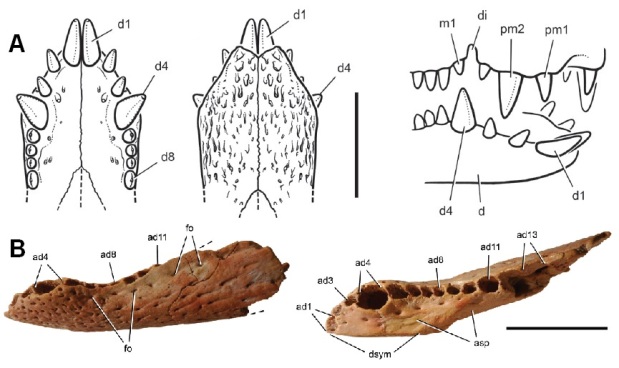
Araripesuchus rattoides, based on the holotype CMN 41893. A, drawing showing paried mandibles and the interpremaxillary diastema other Araripesuchus have. B, showing the holotype. C’mon, does that look like a rodent to you? After Sereno & Larsson (2009).
But only two crocs have lost whole sections of dentition, one being Lotosaurus adentus (Zhang, 1975):

Cast of skeleton of Lotosaurus adentus. Not all of this is real. From the website for the Fukui Prefectural Dinosaur Museum.
It certainly looks fascinating, but aside from Zhang’s brief and inadequate description and some horrible plates, nothing is known of it.
update: Okay, so I fudged this bit. Lotosaurus adentus is joined by a few other taxa, the peculiar Effigia okeeffeae (Nesbitt and Norell, 2006) and its close ally Shuvosaurus inexpectatus (Chatterjee, 1993), the latter which was originally thought by Sankar Chatterjee to be an ornithomimid but later found to be a synonym of the decidedly un-ornithomimid Chatterjeea elegans (Long and Murray, 1995), which is doubly peculiar because Chatterjee knew the material came from Triassic rocks in the Chinle Group (Bull Canyon Formation for both Shuvosaurus inexpectatus and Chatterjeea elegans, Rock Point Formation for Effigia okeeffeae). A Triassic ornithomimid? Yeah, you’re not the only one. We’re glossing over Lucas, Spielman and Hunt (2007)’s assertion that we should just lump all these taxa into one form as they argue the species okkeeffeae and inexpectatus (where the latter included elegans) should remain separate, and there is no essential reason to not retain the full bionomina separately instead of species (after all, “genera” don’t exist!).

Skeleton of Effigia okeeffeae, from Nesbitt and Norell (2006), and stolen from the AMNH website. This is roughly what we’d expect Shuvosaurus to look like, combining Chatterjeea’s postcrania and Shuvosaurus’ skull.
And … I also forgot to mention aetosaurs. While these basal crocodyliforms start out toothy, they progressively lost their teeth. And that change is something to be noted, but perhaps later, as they also changed the form of their teeth and developed a few other interesting bits about their jaws. They end up looking like crocs in armor only. Very derived aetosaurs like Desmatosuchus and Paratypothorax had edentulous premaxillae and the mesial ends of their mandibles were devoid of teeth, a similarity strikingly close to the therizinosaur Erlikosaurus andrewsi (Barsbold and Perle, 1980), and a feature very different from the small Aetosaurus, namesake for the group and rather a toothy and carnivorous fellow.
Straying Spade Jaw [n1]
The “other” [note: see above] croc is Macelognathus vagans, which I previously noted here. Originally named from a partial mandible from Quarry 9 in the Let Jurassic Morrison Formation (YPM 1415, see below) as part of a strange group of reptiles (the “order” Macelognatha) apparently associated with turtles (Marsh felt the long symphysis excluded the jaw from dinosaurs, while the beak excluded it from crocs) by the over-profuse Othniel Charles Marsh, Macelognathus vagans was based on a small partial mandible including the entire symphyseal region and a section of the right splenial extending from the symphysis along the dentary. Later, Ostrom (1971) would recognize that the long symphysis with involved splenial contact secured this strange jaw as coming from a croc, and it’s only at this point that the story gets interesting.
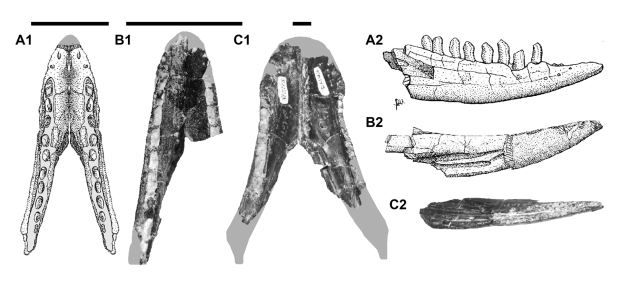
Mandibles of Macelognathus vagans. A, LACM 4684/133772; B, LACM 4684/128271; C, YPM 1415, the holotype. 1 indicates dorsal view, 2 indicates right lateral view, where in C2 this corresponds to right medial view, while in B2 the post-symphyseal portion of the right dentary is missing, exposing the left mandible in medial view. Grey underlay indicates restored missing material, including completion of the rostral curvature of the dentaries. LACM 4684/133772 is a left mandible, shown flipped in A2 and mirrored and paired in A1. Scale bars equal 1 cm. Modified after Göhlich et al. (2005).
Subsequent work by various researchers, including Ostrom (1971) and Göhlich et al. (2005) have added to our knowledge. Ostrom redescribed the type mandible, and provided the best information we had to date. His work was substantive enough that, when Göhlich reapproached this work over 30 years later, they did not do much to alter the description, merely supplementing it with a number of additional specimens from elsewhere in the Morrison Formation, but with 9as seen above) very similar jaws. Göhlich et al. (2005) were initially cautious about including the mandibles in with the holotype, but the lack of any seriously competitive identification (the only other “similar” jaw was that of Kayentasuchus walkeri (Clark and Sues, 2002), another “sphenosuchian”-grade croc) made the decision easier. Such referral is never permanent, and it is not hard to shift specimens around should new information arrive; the authors tooth the conservative route which, in the easiest course, applies specimens to the most recognizable container, in this case Macelognathus vagans. More dramatic steps, possibly more appropriate, would be to set them aside as Macelognathus sp., “Sphenosuchia” indet., etc. and the most radical would be to make new taxonomy. Much of the new material indicates a smaller animal than the holotype, exemplified by the presences of multiple jaws showing distinct size differences and different numbers of alveoli relative to the length of the mandibular symphysis, as well as how many alveoli are situated mesial to the posterior margin of the symphysis.
The mandibles have not been studied extensively as to the structure of the edentulous portion of the jaw, but what has been done has indicated there is most likely a keratinous beak: a rhamphotheca, if you will. This includes the increased number of external foramina, and rather large ones; a fluted margin, although restricted to the dorsal, or lingual surface; and the obvious lack of any teeth (although this last bit need not be indicative itself of a rhamphothecal covering, it might help). The teeth are not simple cones, they are mediolateral compressed and recurved, though like most crocs they exhibit an expanded root and constriction below the crown, resulting in a “waisted” and somewhat lanceolate tooth shape. They are also unserrated and instead of tapering to a point, regardless of their curvature, they are rounded around the apex; they resemble odd spoons. These were not the teeth of carnivores.
So, we have an apparent “herbivore” (or whatever) sporting some weird teeth for a croc, and a rostral beak; it might even correspond, like Araripesuchus, to a gap or full edentulous region of the upper jaw. The lack of an enlarged rostral dentary crown, or any caniniform tooth, as indicated by the lack of an enlarged alveolus or (in LACM 4684/133772, the tooth itself) is at striking odds with most crocodyliforms. We have several specimens, and what they show is that instead of gradually growing teeth into the edentulous region, the region instead expands.
The postcrania is striking, in that association with several cranial elements suggest to Göhlich et al. (2005) that the mandibles belonged to a particular type of croc, the crocodylomorphan “sphenosuchians,” especially something as long-legged as Terrestrisuchus gracilis:
There is enough material that, in fact, we can picture what Macelognathus vagans looked like in general, and this implies a very slender- and long-limbed animal. We know the last bit because of some peculiarites that the leggy “sphenosuchians” have, including a parasagittally arranged hip joint and very elongate and slender metatarsals and forelimb bones, which themselves show limited points for large lateral muscles; everything was inline with pulling the limbs back and forth, and very little left and right.
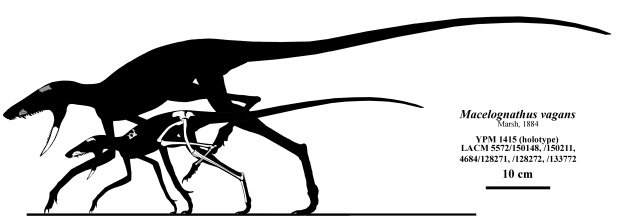
Skeletons of Macelognathus vagans. The larger skeleton indicates YPM 1415, the holotype, while the smaller one is represented from several specimens described by Göhlich et al. (2005) and scaled to the largest of them after Terrestrisuchus gracilis and another “sphenosuchian,” Hallopus victor. Both are shown in a high-stepping trot.
But this isn’t being shown for your enjoyment of my skeletal artistic skills, nor my current disregard for Greg Paul’s demand that skeletons done in the above manner should be discontinued. No, they show something else. Here we have a highly cursorial, small croc with an unusual dentition and rostrally-edentulous jaw. It probably had an edentulous rostral upper jaw. It was probably not a carnivore, and more likely a consumer of the finer, buggier or herbaceous things in life. It may have followed the shoebill, Balaeniceps rex, in being an inveterate predator of small invertebrates, in which large serrated teeth are a massive hindrance but toothlessness or blunted, robust teeth were not.
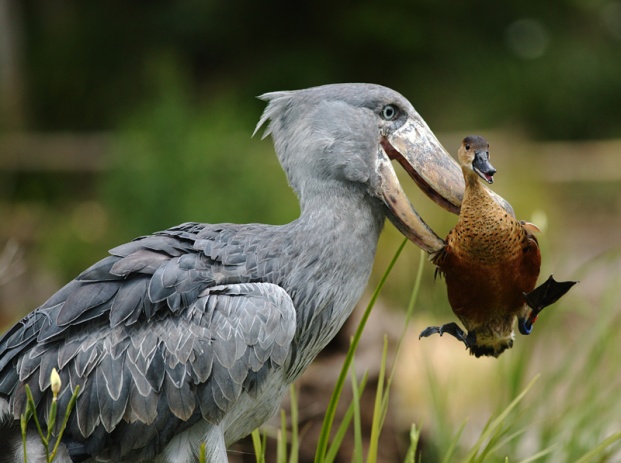
A poor, weak shoebill defending itself from a marauding duck. Poor guy. Maybe Macelognathus could take a few lizards, at least…. (It has been suggested that this is photoshopped, which may be true; I merely include it because this behavior is known at least for shoebills and fish, and thus it may not be a poor extrapolation to suggest possible terrestrial vertebrates were preyed upon in this manner.)
Jumping Foot, the Winner [n2]
There’s a good chance that Macelognathus vagans is actually another animal. Another croc. You see, Macelognathus vagans comes from the Morrison Formation. The holotype derives from Quarry 9 at Como Bluff, Albany County (Como Bluff extends also into Carbon County), Wyoming, one of Marsh’s original quarries and is in short a microvertebrate site; few remains of large vertebrates come from here, save teeth (and we all know those don’t count![n3]). Quarry 9 lies in the upper Brushy Basin Member of the Formation. The referred specimens come from the Fruita Main and Fruita General localities in the base of the Brushy Basin Member, in the Fruita Paleontological Area, Mesa County, Colorado. The Brushy Basin Member is predominately composed of fine silt and mudstones, laden with ash, and were part of the deposition of a large alkaline lake. Most remains were likely victims or exploiters of victims of a hostile environment.
But there is an another …
… croc … in the Morrison. Hallopus victor. Marsh also named this one (Marsh, 1877), this time from a much better specimen (relatively speaking … I mean, at least there’s more of it), and also as a dinosaur (Hallopoda!). The holotype, and only known specimen, YPM 1914, is a large portion of the skeleton preserved as partial bones and mostly impressions of many others in a sandstone slab split in to (thus there are two specimens, YPM 1914A and YPM 1914B). Most of the details below are thus cobbled from two imperfectly overlapping slabs which nonetheless reveal much of the pelvis and hindlimb, portions of the forelimb, little of the vertebrae, and a few details of the skull. Nonetheless, the specimens are pieces of crap, as the details of the impressions in the slab and the broken and split form of the original bone makes description virtually impossible. Walker (1970) in redescribing these specimens managed to conclude far more than Marsh, placing it within the Sphenosuchia, lamented of the need to essentially cast the impressions to make positives from which to work with, and despite these (also used by Göhlich et al., 2005) Walker’s is the only work to come to modern times.
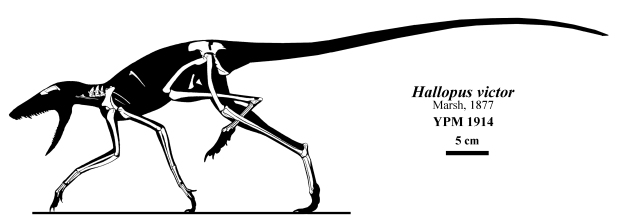
Hallopus victor, YPM 1914, in all its incomplete but leggy glory. Much of the skeleton is comprised of negative impressions, which I normally shade in grey; here, because some of them are partially filled in bone, I’ve chosen to take the cheater’s route and show all of it in “true bone” white.
Actually, there’s not much more here than there is in the Fruita specimens Göhlich et al. describe, and it’s a little smaller than I project from YPM 1415, but it’s not how much there is that counts. Hallopus is at the core of a small mystery, which is part of the bigger problem that was O. C. Marsh and his ridiculous rivalry with E. D. Cope. I won’t rehash the Bone Wars, but suffice it to say, Marsh did two things really badly during that time that messed up paleontology of his area for everyone since: the first was that he and the men he paid to collect fossils seldom kept the detailed records we expect of our field workers and geologists today, so that accurate accounts of where and how material is collected is known, knowable, and further workers are able to track this info to find more; the other is that Marsh deliberately did some of this to prevent his rivals from finding material Marsh wanted instead — so this level of obfuscation, not necessarily restricted to Marsh but also to Cope, confounds the ability to figure out the provenance, formation, and even age of the material he described.
This situation has been dealt with in some detail by various workers, who had to try to track down these localities just to find this information. Williston (1905) attempted to pinpoint the quarries of several specimens by following the notes left by Marsh, to little avail. Ague, Carpenter and Ostrom (1995) — 90 years later! — published the results of hands on work recording both the efforts of modern geologic exploration (examining the minerology of the matrix of the Hallopus slabs) and good old fashioned walking, finding the locality hinted at by Marsh’s less-than-accurate “records” by matching said minerals, although this is broadly applicable. Thus they affirm the site of location is in central Colorado’s Fremont County, at Cope’s Nipple (Marsh’s little joke), and was located somewhere in the middle of the Brushy Basin Member. They could be wrong, and argue otherwise, but science marches forward, and Göhlich et al. are hesitant to agree fully with Ague et al. on this matter.
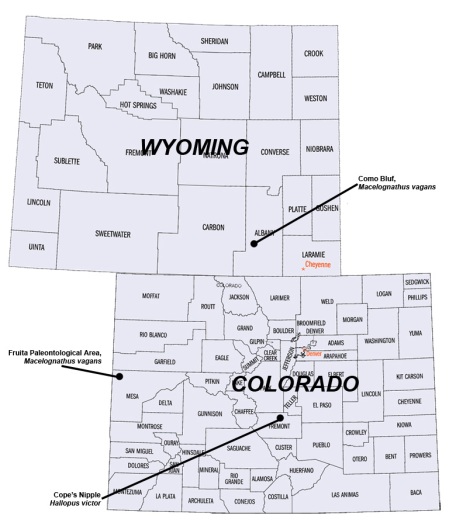
Map of the counties of Wyoming and Colorado (USA) showing the locations of the three primary localities discussed in the text. They form a rough equilateral triangle.
I bring this up because, for various reasons, Hallopus victor and Macelognathus vagans could be the spitting image of one another. And the likelihood of two very, very similar taxa in the same region of the formation, overlapping in time and space, is low. This is not to say it is impossible, and I cannot discount the two taxa are dissimilar. However, virtually all of the postcranial agrees strongly with one another; the Cope’s Nipple and Fruita specimens especially are highly indicative of a single morphology, when comparing the pelvis and hindlimb, that were they found without mandibles associated, it is more likely we’d see these specimens referred to Hallopus victor instead (of course, this is ignoring the issue of doubting the taxon’s provenance).
So when I said Göhlich et al. were conservative in their taxonomy, I meant it. They not only refrained from making that many comments about Hallopus victor, they did consider the issue (a conversation with Ursula Göhlich in 2005 helped clear some of the Hallopus debate here), but set Hallopus victor aside in order to make the stronger referral. So, if Macelognathus vagans is referrable to Hallopus victor (which is the older name, and thus has priority), the specimens referred to the former would suddenly fall into the latter, and we are all happy. Note that I am not complaining: I think Göhlich et al. make the correct moves in this situation, with the slight caveat that I would have been more cautious in referring the postcrania to Macelognathus vagans. We can’t have everything.
Synthesis
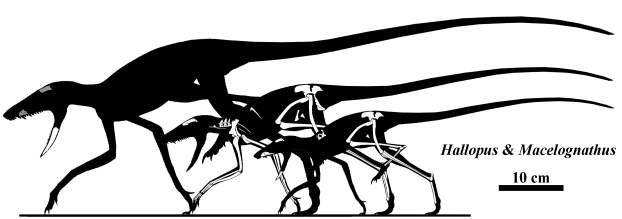
“Hallopus victor” if it were a single animal comprising the Quarry 9, Cope’s Nipple and Fruita specimens, all scaled to size.
And here they all are, together, for the first time. There is no use in drawing a composite skeleton. This would largely consist of scaling of the Fruita maxilla and scaling down the Quarry 9 mandible, then scaling everything up to Quarry 9 standards using the Fruita specimens as a guide; but this has problems, as none of the Fruita specimens can be said to belong to singular individuals, much of the cranial and limb material are not associated enough to project a maxilla specimen from both cranial and limb elements. The chance exists that none of the cranial material belongs to the limb material, making the whole issue (and consequently Göhlich et al., 2005 referral) moot. The case is strong though, that the material all belongs to one taxon (even if there’s a nagging doubt — but there always is! Welcome to being a scientist!), and any further material shown not to belong by further specimens and study can be removed. IF — if if if! — the specimens are all close enough to be a single taxon, then what you see above is a probably growth series, with the type of Macelognathus vagans as the largest known and likely adult specimen; the rest would be subadults and juveniles. This then implies that both Hallopus victor and Macelognathus vagans maxed out around a meter in length, so they were quite small.
Obviously, the story won’t end here. There is more going on in these sites, and further expeditions to various sites will reveal more. The Fruita quarries are producing many moderately-sized vertebrate remains, and the Morrison hasn’t been quite worked out (as in, run dry, producing no more new things) yet, as it is one of the most widely-exposed terrestrial formations in North America. Hallopus victor, despite recent research trying to recover from Marsh’s lackadaisical idea of “work,” remains something of an enigma, and Macelognathus vagans has been caught along.
[n1] Greek μακίλλα [makella] (a spade, a hoe) and Greek γνάθος [gnathos] (jaw), and Latin vagans (wandering, or straying). I suspect the specific epithet is warning of the oddity of the specimen, and Marsh’s inference that it represented an animal associated with turtles, not quite any other type of reptile. It didn’t help that YPM 1415 was found associated with turtle bits.
[n2]Greek άλλο, from άλλομαι [‘allomai or hallomai, shortened to hallo] (jumping) and Greek ποΰς [pous] (a foot), and Latin victor (winner). I’m not sure what Marsh had going here, as unlike most of his other names, this is a noun in apposition to another noun. “Victor” might easily be used as “baatar” is used for Mongolian taxa, as both are nouns and may be used relatively similarly.
[n3] I kid! I kid!
Ague, J. J., Carpenter, K. & Ostrom, J. H. 1995. Solution to the Hallopus enigma? American Journal of Science 295:1-17.
Barsbold R. & Perle A. Segnosauria, a new Infraorder of carnivorous dinosaurs. Acta Palaeontologica Polonica 25(2):187-195.
Chatterjee, S. 1993. Shuvosaurus, a new theropod: an unusual theropod dinosaur from the Triassic of Texas. National Geographic Research and Exploration 9(3):274–285.
Clark, J. M & Sues, H.-D. 2002. Two new basal crocodylomorph archosaur from the Lower Jurassic and the monophyly of the Sphenosuchia. Zoological Journal of the Linnean Society 136:77-95.
Göhlich, U. B., Chiappe, L. M., Clark, J. M. & Sues, H.-D. 2005.The systematic position of the Late Jurassic alleged dinosaur Macelognathus (Crocodylomorpha: Sphenosuchia). Canadian Journal of Earth Sciences — Revue canadienne de sciences de la Terre 42(3):307-321.
Long, R. A. and Murry, P. A. 1995. Late Triassic (Carnian and Norian) tetrapods from the Southwestern United States. New Mexico Museum Natural History Science Bulletin 4:1-254.
Lucas, S. G., Spielman, J. A. & Hunt, A. P. 2007. Taxonomy of Shuvosaurus, a Late Triassic archosaur from the Chinle Group, American southwest. In Lucas & Spielman (eds.) The Global Triassic. New Mexico Museum of Natural History and Science Bulletin 41:259-261.
Marsh, O. C. 1877. Notice of some new vertebrate fossils. American Journal of Science (Series 3) 14:249-256.
Marsh, O. C. 1884. A new order of extinct Jurassic reptiles (Macelognatha). American Journal of Science (Series 3) 27:341.
Nesbitt, S. J. & Norell, M. A. 2006. Extreme convergence in the body plans of an early suchian (Archosauria) and ornithomimid dinosaurs (Theropoda). Proceedings of the Royal Society of London, B 273:1045–1048.
Ostrom, J. H. 1971. On the systematic position of Macelognathus vagans. Postilla 153:1–10.
Sereno, P. C. & Larsson, H. C. E. 2009. Cretaceous crocodyliforms from the Sahara. ZooKeys 28:1-143.
Walker, A. D. 1970. A revision of the Jurassic reptile Hallopus victor (Marsh), with remarks on the classification of crocodiles. Philosophical Transactions of the Royal Society of London, Series B 257:323-372.
Williston, S. W. 1905. The Hallopus, Baptanodon, and Atlantosaurus beds of Marsh. Journal of Geology 13(4):338-350.
Zhang F.-c. 1975. [A new thecodont, Lotosaurus, from Middle Triassic of Hunan]. Vertebrata PalAsiatica 13:144-147. [in Chinese]




Lotosaurus appears to be related to two other toothless suchians, Shuvosaurus and Effigia.
I went ahead and replied down yonder (to Mickey), but also emended the post. With an update!
Very interesting stuff, as usual. I thought Hallopus was opisthopubic –is that still considered true?
The Shoebill Balaeniceps is specialized in eating lungfish, not invertebrates.
The pubic orientation of Hallopus is impossible to gague, as the material is based on impressions that do not properly connect, as well as shapes that, if other “sphenosuchians” are taken into account, do not actually indicate opisthopuby. I’ve played the moderate game and made the pubes mesopubic.
My data on shoebills has them as invertebrate, small vertebrate generalists, regardless of their tendency for lungfish. The picture (if it isn’t faked) shows a typical stork’s ability to go after anything that will fit in the bill in its environment, and lungfish when sized will fit this bill (no pun intended).
According to the backstory on that photo, the shoebill was just moving the duck out of the way (http://www.dailymail.co.uk/news/worldnews/article-1225223/Dont-forget-duck-Giant-Shoebill-picks-feathered-friend-blocks-path.html).
On the other hand, perhaps a failed predation attempt can’t entirely be discounted…
But it was included not because it indicated an act of predation, but because it was funny. I’m trying to lighten the over-seriousness with which I usually write.
Thanks for clarifying on the (unclear) pubis orientation of Hallopus.
Sorry, your “data” on the diet of the Shoebill is mistaken. Look in Wikipedia, Handbook of Birds of the World, or anywhere else reliable and you will see there is nothing ambiguous about the Shoebill eating mainly lungfish and other small wetland vertebrates –but not invertebrates.
Maybe your data was based on what storks proper eat, but Shoebills are not true storks; in fact, they are more closely related to pelicans.
I tend not to take various public sources seriously, but, here’s Wikipedia:
This source, which i include only for ease of finding at the moment, mentions that diet is mainly fish, sometimes frogs, and most lungfish when there is fish.
This does not stop them from generalizing, and in fact seasonality of lungfish availability precludes this. Most other sources emphasize its foraging behavior, digging through mud, but this also does not stop them from consuming available foods.
No, but it stops Shoebills from ” being an inveterate predator of invertebrates”, which is what you wrote and is all I am reacting to.
We might be getting a little confused then. I never said it was only a predator of invertebrates, although i suppose “inveterate” can imply something like that, as if it were an arch predator. Of course, the term “invertebrate” was wrong as well, so I will correct this.
And don’t forget derived aetosaurs.
Oh, aetosaurs (and Effigia/Shuvosaurus) don’t count! See, I didn’t include them, so they must not exist! (I will simply change the Lotosaurus attribution to include the “shuvosaurs,” but I simply have no way to put in aetosaurs and their shortened dentition, so they are unfortunate casualties to my truthiness.
Shuvosaurines and derived ctenosauriscds do not appear to have inherited toothlessness from a common ancestor. Rather, recent studies seem to indicate that both evolved independently from toothed members of the Poposauroidea (given that Arizonasaurus and Poposaurus have big nasty teeth, for example). So I guess you could say toothlessness evolved three or more times in non-croc crocodylian line archosaurs.
Quite likely.
Do we actually know Poposaurus had teeth? It was my impression no cranial remains had been recovered, though I don’t follow pseudosuchians as closely as theropods…
Weinbaum and Hungerbühler (2007) report that the hypodigm for both species (langstoni, gracilis) remain devoid of cranial material; they include vertebrae, limb, and pelvic material exclusively. A maxilla, TMM-31098-46, is tentatively suggested as belonging to Poposaurus gracilis (from the Otis Chalk), and is said to be similar to Arizonasaurus babbitti, but may also derive from Postosuchus kirkpatricki although is dissimilar. The maxilla has alveoli for several teeth, and is almost the entire object, so it resembled a typical poposauroid maxilla.
Weinbaum, J. C. & Hungerbühler, A. 2007. A revision of Poposaurus gracilis (Archosauria: Suchia) based on two new specimens from the Late Triassic of the southwestern U.S.A. Paläontologische Zeitschrift 81/82:131-145.
Supposedly that new, nearly complete Poposaurus from Grand Staircase-Escalante has some associated teeth and skull fragments. Big ones.